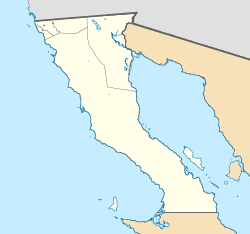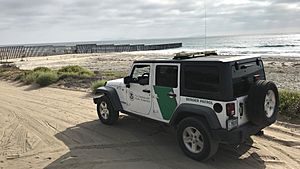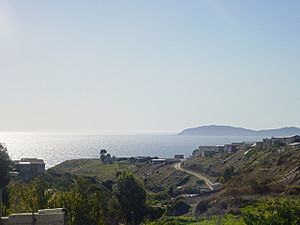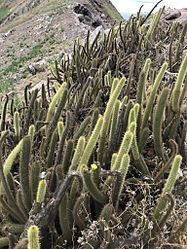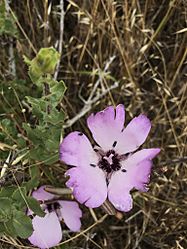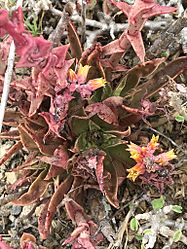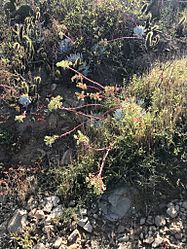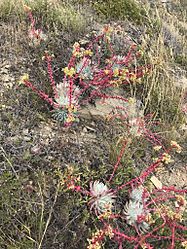Coronado Islands facts for kids
|
Native name:
Islas Coronado
|
|
|---|---|
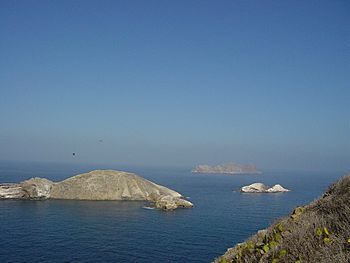
North Coronado (right background), Central Coronado (left midground), and Pile of Sugar (right midground) viewed from South Coronado (foreground)
|
|
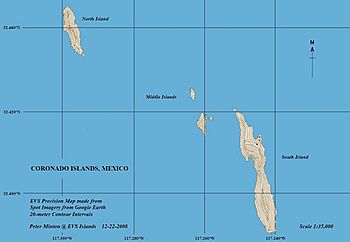
A map of the four Coronado Islands
|
|
| Geography | |
| Location | Southern California Bight |
| Coordinates | 32°25.05′N 117°15.63′W / 32.41750°N 117.26050°W |
| Major islands | 4 |
| Administration | |
| State | Baja California |
| Municipality | Tijuana Municipality |
The Coronado Islands (also called Islas Coronado or Islas Coronados) are a group of islands. They are located about 13 km (8 mi) off the northwest coast of Mexico in the state of Baja California. These rocky islands are often hit by wind and waves. Most of them are empty, except for a small group of military staff and a lighthouse keeper.
Even though they look bare, the islands are a safe place for seabirds. They also have many plants, including 6 types found only there. The waters around the islands are full of different kinds of sea life. For thousands of years, native people used these islands. European explorers first saw them in 1542.
Later, the islands became popular for weekend trips and even secret meeting spots. The city of Coronado, California, about 27 km (17 mi) north, was named after these islands in 1886. During World War II, Mexico and the United States used the islands for military training. Today, the islands are a Mexican wildlife refuge. Visitors can anchor boats, scuba dive, and snorkel. However, stepping onto the islands is not allowed without special permission from the government.
Contents
Exploring the Coronado Islands' Location
The Coronado Islands are in the middle of the Southern California Bight. They are part of Mexico's special ocean area. These islands are actually pieces of land that were pushed up by the movement of the Pacific and North American plates. West of the islands, there are underwater cliffs that drop into a deep channel, over 1,100 m (3,600 ft) deep.
The biggest island, South Coronado, is about 13 km (8 mi) from the Mexican mainland. It is also about 12 km (7 mi) south of the border with the United States. The islands are controlled by Mexico and are part of the Tijuana Municipality in Baja California.
The group of islands stretches out over 8 km (5 mi). There are four main islands:
- Coronado Norte (North Coronado or North Island) is located at 32°26′N 117°18′W / 32.433°N 117.300°W. It covers about 48 ha (120 acres). This island has many small areas for plants to grow. Its weather is like that of southern Point Loma.
- Pilón de Azúcar (Pile of Sugar or Middle Rock) is at 32°25′N 117°16′W / 32.417°N 117.267°W. It covers about 7 ha (17 acres). This island has a rocky hill and a smaller ridge. Not many plants grow here because the soil is poor.
- Coronado Centro (Central Coronado or Middle Island) is located at 32°25′N 117°16′W / 32.417°N 117.267°W. It covers about 14 ha (35 acres). This island has a steep hill and a protected cove called Moonlight Cove. Strong winds and waves have shaped this island.
- Coronado Sur (South Coronado or South Island) is at 32°25′N 117°15′W / 32.417°N 117.250°W. It covers 183 ha (450 acres). This island is 3.2 km (2.0 mi) long and 800 m (2,600 ft) wide. It has the only bay among the islands, called Puerto Cueva Cove. South Island has two main peaks. Middle Peak is about 180 m (590 ft) high, and South Peak is about 160 m (520 ft) high. There are a few buildings and two lighthouses on this island.
History of the Coronado Islands
Early Visitors and Discoveries
People have visited the Coronado Islands for over 1,000 years. Since there is no fresh water, people could not live there permanently. However, native groups like the Kumeyaay often visited. They likely set up small, temporary camps for special practices. Old tools and pottery have been found on both islands. For example, on North Island, a small cave was said to have pieces of pottery. On South Island, many other ancient sites exist.
Later studies confirmed that pottery pieces were found on South Island. These pieces were likely cooking pots. They show that people lived on the islands on and off between 1390 and 820 years ago.
In 1542, a Portuguese explorer named Juan Rodríguez Cabrillo was the first European to see the islands. He called them Las Islas Desiertas (the desert islands) because they looked so bare. In 1602, another explorer's priest named Father Antonio de la Ascención called them Los Cuatro Coronados (the four crowned ones). This name honored four brothers who died for their Christian faith. Fishermen later gave them other names like Old Stone Face or Dead Man's Island.
Islands in Business and Travel
Starting in the 1860s, local newspapers began advertising day trips to the islands. At the same time, people started fishing for rock cod around the islands.
In 1872, the Mexican Navy began visiting the islands. They wanted to prevent people from causing damage. Even so, business activities continued. High-quality building stone was found on North Island in 1872. Some people tried to use this stone for building, but the project did not last long. At one point, the islands were used as a stop-over for people trying to enter California. This stopped after a group of people were found abandoned on the island.
In the 1920s and 1930s, during a time called Prohibition (when alcohol was illegal in the U.S.), a cove on South Coronado Island was used as a meeting place. Many boats came and went, sometimes causing crashes in the fog. A famous casino, the Coronado Islands Yacht Club, was built there. It was a large, two-story building. The casino did well even during the Great Depression. However, the Mexican government made gambling illegal, so it became a weekend hotel. Later, Mexican soldiers used it as a base. A big storm in 1988 destroyed the building. Only its stone foundation remains today. This area is still known as Smugglers Cove.
World War II and Today
In 1942, Mexico joined World War II. Soon after, Mexico and the United States used the islands for military training. Mexican Navy soldiers were stationed on South Island.
In May 1943, a U.S. Navy ship, the USS PC-815, was commanded by L. Ron Hubbard. He later founded Scientology. Hubbard ordered gunnery exercises and shelled the Coronado Islands. He believed they were empty and belonged to the United States. However, the islands belonged to Mexico and had Mexican soldiers on them. The Mexican government complained, and Hubbard was removed from his command.
In October 1944, a plane crashed on South Coronado. Lieutenant Robert D. Cullinane and his 12 crew members died. Parts of the plane can still be found on the western side of South Island.
Today, the Coronado Islands are part of the Tijuana Municipality in Baja California. The only people living on the islands are Mexican Navy staff and a lighthouse keeper on South Island. The islands are a protected natural area. Only government workers and approved scientists can go onto the islands.
Even though landing on the islands is not allowed, the waters around them are popular. Many people come here for diving, snorkeling, and fishing.
Island Wildlife and Plants
Plant Life on the Islands
Even though the islands look rocky and bare, they have many different plant species. The types of plants vary on each island due to the land, soil, and human activity. Most of the plants are part of a group called maritime succulent scrub. These plants are mostly succulents and rely on ocean fog for moisture. This plant community is found in areas with a Mediterranean climate and also in desert areas.
This habitat is common in northwestern Baja California. It is also found on other nearby islands like Isla San Martin and Todos Santos Island. Some plants found here include Dudleya species and cacti like the coastal cholla (Cylindropuntia prolifera).
- Flora of the Coronado Islands
-
Bergerocactus emoryi on a ridge on North Coronado
-
An endemic succulent, Dudleya candida, with Opuntia species
On South Island, near the lighthouse, the plants are a bit different. Here, you find plants like California sagebrush (Artemisia californica) and lemonade berry (Rhus integrifolia). Some plants found only on the islands, like Galium coronadoense, also grow here. Non-native plants, such as crystalline ice plant, are found in disturbed areas. Interestingly, this plant provides shelter for the local rattlesnake.
Animal Life on the Islands
Many birds nest on the islands and can be seen in the nearby waters. These include gulls, cormorants, pelicans, and storm-petrels. The Coronado Islands have the largest known group of the rare Scripps's murrelet. Middle Rock is home to the most northern nesting group of brown boobies on the west coast of North America.
Ten types of reptiles and amphibians live on the islands. The most famous is the Coronado rattlesnake (Crotalus oreganus caliginis). This snake is smaller than the ones on the mainland. There is also the Coronado Island gopher snake, which eats bird eggs. The Coronado skink is found on all four islands. Arboreal salamanders live on the three biggest islands. Southern alligator lizards are on the north, south, and central islands.
Two types of land mammals live on the islands: rabbits and mice. No one knows for sure how they got there.
Sea mammals are very common around the islands. You can often see groups of California sea lions and seals. Middle Island has a small group of northern elephant seals.
See also
 In Spanish: Islas Coronado para niños
In Spanish: Islas Coronado para niños


